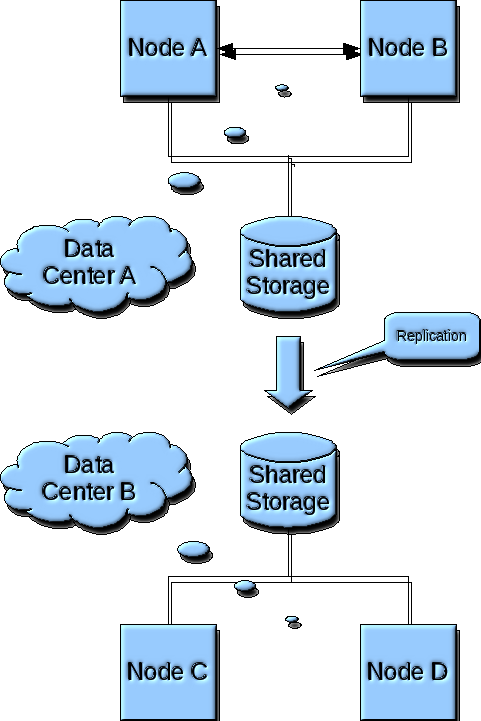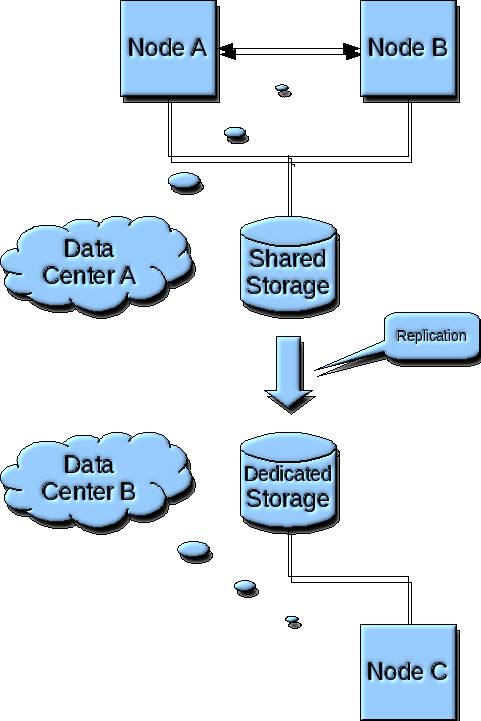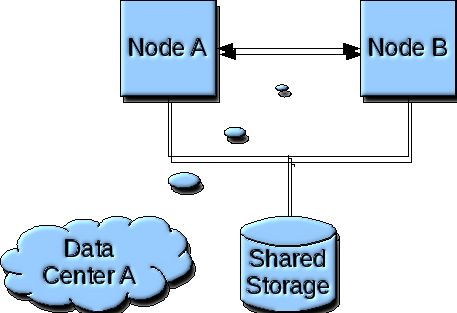
Mt Xia delivers automated solutions for deploying business continuity (BC), disaster recovery (DR), high availability (HA), and virtualization (VIO) as a consumer commodity. This packaged solution called vLPARtm is sold by Mt Xia as an appliance that can plug directly into your datacenter and reduce your administration costs by 75%. vLPARtm can also increase your profits by fully implementing IBM Power 5 architectures and over-subscribing available hardware resources to multiple customers, thus maximizing your return-on-investment (ROI).
The business continuity methodology developed by Mt Xia and implemented by vLPARtm is characterized by a "build once, run anywhere" mentality. This phrase is meant to illustrate the concept of "containerized" business functions, where all resources related to supporting a business function are grouped together in such a way as to be able to run on any compatible system, in any datacenter, anywhere in the world.
Each component and piece of a containerized business function is constructed using enterprise wide unique identifiers so that naming and numbering conflicts are eliminated, thus enabling the "build once, run anywhere" mentality. In fact, this container concept enables multiple containers to run simultaneously on the same system, which is a common practice when implementing a disaster recovery plan. In disaster recovery operations, production systems are commonly consolidated onto a single system in the disaster recovery environment.
With vLPARtm, a datacenter operator has the ability to offer it's customers on-demand disaster recovery / high availability clusters, or standalone systems, built in real-time, and all of them being generated by the customer from a simple web based interface.
For a customer to create their own BC/DR/HA/VIO solutions, they only need to complete one simple web form. Their request is automatically processed and system(s) are created in a matter of minutes, they are notified upon completion and provided with a login name and password to a fully functional cluster of systems. (DR/HA).
vLPARtm is a true on-demand, turn-key computing solution delivered as a consumer commodity providing automated deployment of business continuity, disaster recovery, high availability and virtualized solutions. These solutions include standardized architectures, service level agreements (SLA), billing structures, and automatically generated documentation.
vLPARtm Features
Additional packages integrated into vLPAR:
Click here for screen shots and animations of vLPAR client LPAR creation procedures.
VLPAR provides the automated deployment of multiple systems, depending upon the service level agreement(SLA) selected by the user when building a business solution. Those SLA's are described and depicted below.
The following diagram depicts the Disaster Recovery and High Availability scenario for a Tier 1 service agreement level, as implemented by VLPARtm automated deployment. Under this scenario, four(4) nodes are created across two datacenters, two nodes in each datacenter.
In this scenario, both datacenters are considered to be running production business functions. These functions normally run on a single node in one of the datacenters, with a hot-standby node providing high availability fail-over capabilities. Periodically, for maintenance and disaster recovery testing, the business function load is shifted from one datacenter to the other. Once the business functions are running in the other datacenter, it is not failed-back until the next scheduled maintenance or an unscheduled outage to the datacenter occurs.

The following diagram depicts the Disaster Recovery and High Availability scenario for a Tier 2 service agreement level, as implemented by VLPARtm automated deployment. Under this scenario, three(3) nodes are created across two datacenters, two nodes in the primary production datacenter, one node in the disaster recovery datacenter.
In this scenario, the business functions are normally is normally running on a single node in the production datacenter. In the event of a hardware failure, the business functions are failed-over to a hot-standby node in the production datacenter. In the event of a datacenter failure, the business functions are failed-over to a hot-standby node in the disaster recovery datacenter.

The following diagram depicts the Disaster Recovery scenario for a Tier 3 service agreement level, as implemented by VLPARtm automated deployment. Under this scenario, two(2) nodes are created across two datacenters, one node in each datacenter.
In this scenario, the business functions are running on running on a single node in the production datacenter. No high availability failover is provided, so in the event of a hardware failure on the production node, management must declare a disaster in order for a disaster recovery failover to be initiated. When a disaster is declared, the business functions are restarted on the disaster recovery node.

The following diagram depicts the Disaster Recovery and High Availability scenario for a Tier 4 service agreement level(SLA), as implemented by VLPARtm automated deployment. Under this scenario, two(2) nodes are created in an HACMP cluster within a single datacenter.
In this scenario, a two(2) node one-way cascading HACMP cluster is running in the production datacenter. The business functions normally run on a single node in the cluster, with a hot-standby node providing high availability fail-over capabilities. In the event of a hardware failure, the business functions are failed-over to the hot-standby node. In the event of a disaster, no pre-built provisions exist.

The following diagram depicts the Disaster Recovery and High Availability scenario for a Tier 5 service agreement level(SLA), as implemented by VLPARtm automated deployment. Under this scenario, one(1) node is created as a standalone systems within a single datacenter.
In this scenario, a single standalone system exists running the business functions, no high availability fail-over or disaster recovery fail-over provisions exist. If a hardware failure occurs, the business functions provided by the node will be unavailable until the failure is corrected.
